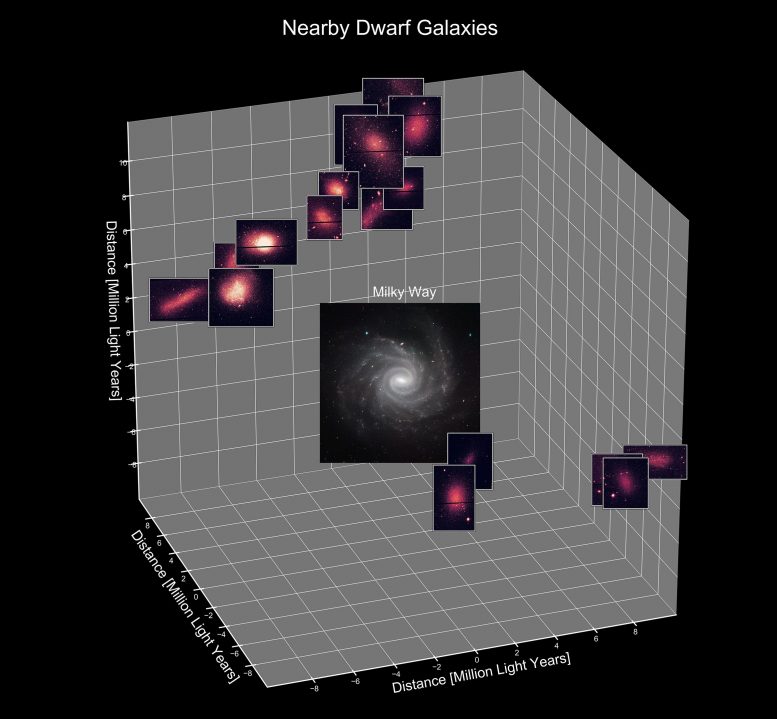Rutgers’ unexpected discovery challenges current theories about the growth of galaxies and may improve our understanding of the universe. Credit: Rutgers University-New Brunswick
A surprising discovery calls into question current theories about the growth of galaxies.
Three dozen distant dwarf galaxies have experienced a simultaneous “baby boom” of new stars, an unexpected finding that challenges current theories about galaxy growth and may improve our understanding of the universe.
Galaxies more than a million light years away are expected to have completely independent lives as to when they will give birth to new stars. But galaxies separated by up to 13 million light years have simultaneously slowed and then accelerated their star birth rate, according to a Rutgers-led study published in the Astrophysics Journal.
“It seems these galaxies are responding to a large-scale change in their environment the same way a good economy can spur a baby boom,” said lead author Charlotte Olsen, a doctoral student in the Department of Physics and Science. school astronomy. of Arts and Sciences at Rutgers University – New Brunswick.
“We found that whether these galaxies were neighbors or not, they would stop and then start forming new stars at the same time, as if they were all influencing each other through an extra-galactic social network,” said co-author Eric Gawiser, professor in the Department of Physics and Astronomy.

Three dozen distant dwarf galaxies have had a simultaneous “baby boom” of new stars. Credit: Rutgers University-New Brunswick
The simultaneous decrease in the stellar birth rate in the 36 dwarf galaxies began 6 billion years ago, and the increase began 3 billion years ago. Understanding how galaxies evolve requires unraveling the many processes that affect them over their lifetimes (billions of years). The formation of stars is one of the most fundamental processes. The birth rate of stars can increase as galaxies collide or interact, and galaxies can stop making new stars if the gas (mainly hydrogen) that makes the stars is lost.
Stories of star formation can provide a rich record of environmental conditions as a galaxy “grew”. Dwarf galaxies are the most common but least massive type of galaxies in the universe, and they are particularly sensitive to the effects of their surrounding environment.
The 36 dwarf galaxies included a wide range of environments at distances of up to 13 million light years from the Milky Way. The environmental change that galaxies have apparently responded to has to be something that distributes fuel for galaxies far apart from each other. It could mean encountering a huge cloud of gas, for example, or some phenomenon in the universe that we don’t yet know about, according to Olsen.
Scientists used two methods to compare the stories of star formation. One uses light from individual stars in galaxies; the other uses light from an entire galaxy, including a wide range of colors.
“The full impact of the discovery is not yet known as it remains to be seen how much our current models of galaxy growth must be modified to understand this surprise,” Gawiser said. “If the result cannot be explained within the framework of our current understanding of cosmology, that would be a huge implication, but we must give theorists a chance to read our article and respond with their own research advances.”
“The James Webb Space Telescope, scheduled for launch by NASA in October, will be the perfect way to add this new data to find out how far from the Milky Way this ‘baby boom’ has spread,” he said. added Olsen.
Reference: “Star Formation Histories from Spectral Energy Distributions and Color-magnitude Diagrams Agree: Evidence for Synchronized Star Formation in Local Volume Dwarf Galaxies over the Past 3 Gyr†by Charlotte Olsen, Eric Gawiser, Kartheik Iyer, Kristen BW McQuinn, Benjamin D. Johnson, Grace Telford, Anna C. Wright, Adam Broussard and Peter Kurczynski, May 24, 2021, Astrophysics Journal.
DOI: 10.3847 / 1538-4357 / abf3c2
Rutgers co-authors include Professor Kristen BW McQuinn; Grace Telford, postdoctoral associate; and Adam Broussard, doctoral student. Scientists from the University of Toronto, the Harvard-Smithsonian Center for Astrophysics, Johns Hopkins University and NASA’s Goddard Space Flight Center contributed to the study.
 Universo Viviente
Universo Viviente



